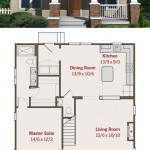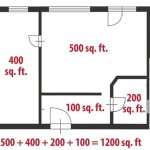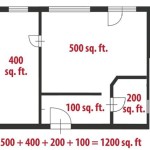How To Find the Floorplan of a Property
Obtaining the floorplan of a property can be a crucial step in various situations, whether you are considering purchasing or renting, planning renovations, or simply seeking to understand the spatial layout of a building. A floorplan provides a visual representation of a property's dimensions, room placements, and overall structure. Finding this information can sometimes be straightforward, while in other instances, it may require more investigative work. This article will explore the various methods and resources available to locate property floorplans, enabling informed decision-making and effective planning.
1. Checking Online Real Estate Listings and Property Portals
The first and often easiest place to search for a floorplan is through online real estate listings. Both active and historical listings can be valuable resources. Major property portals, such as Zillow, Realtor.com, Redfin, and local equivalents, routinely include floorplans as part of their property details. When a property is actively for sale or rent, the listing agent typically provides high-quality images, virtual tours, and, ideally, a detailed floorplan to attract potential buyers or tenants.
To utilize this method effectively, begin by searching for the property's address on the relevant real estate websites. If the property is currently listed, the floorplan, if available, should be readily accessible within the listing details. Look for tabs or sections labeled "Floorplan," "Layout," or "Property Information." Additionally, check the media gallery, as floorplans are sometimes presented as images alongside other property photos. Utilizing search filters specific to available floorplans can also expedite the process.
Even if the property is not currently listed, accessing historical listings can still be beneficial. Many real estate websites maintain archives of past listings, allowing users to view details from previous sales or rentals. The availability of historical floorplans varies depending on the website and the listing's age. Exploring historical data may require creating an account or subscribing to a premium service for access to more comprehensive records.
When examining online listings, carefully verify information such as the floorplan's accuracy. While most listing agents strive for accuracy, errors can occasionally occur. Cross-referencing the floorplan with other available information, such as property descriptions and photographs, can help ensure its validity. Note any discrepancies and consider seeking confirmation from the listing agent or property owner if necessary.
Furthermore, be aware that floorplans from online listing may not be to scale. While they provide a general layout, precise measurements are often not included. Professional floorplans created by architects or surveyors are always preferred for projects that require accurate dimensions.
2. Contacting Real Estate Agents, Property Managers, and Landlords
If a floorplan cannot be readily found online, directly contacting real estate agents, property managers, or landlords can prove to be a beneficial recourse. These professionals often possess access to property information that may not be publicly available. They may have the floorplan in their records or know where to obtain it.
When contacting a real estate agent, focus on those who have previously listed the property. You can identify these agents by searching for historical listings online. Reach out to the agent or their brokerage to inquire about the availability of a floorplan. Clearly state your reason for needing the floorplan and provide the property address. Be prepared to offer proof of your legitimate interest in the property, especially if you are not a potential buyer or tenant. This could include explaining that you are planning renovations or assessing the suitability of the property for a specific purpose.
For rental properties, contacting the property manager or landlord is a direct approach. They typically maintain detailed records of their properties, including floorplans. Request a copy of the floorplan, explaining the purpose of your request. Landlords may be more willing to share this information with current tenants or prospective tenants who have a verifiable interest in renting the property. Transparency about your intentions can increase the likelihood of a positive response.
When communicating with these professionals, remain polite and professional. Be prepared to provide any necessary documentation or information they may require. It's also important to respect their time and privacy. Follow up on your initial inquiry if you do not receive a response within a reasonable timeframe. Patience and persistence can be key to obtaining the desired floorplan.
If direct contact with the relevant parties yields a floorplan, verify its accuracy. Compare the floorplan to the existing layout of the property, if possible, and note any discrepancies. Confirm the dimensions and overall layout to ensure its validity. In some cases, obtaining a professionally drawn floorplan from a surveyor or architect may be necessary if you require precise measurements and detailed information.
3. Exploring Local Government Records and Building Departments
Many local governments maintain records of building permits, property maps, and architectural plans. These records are often accessible to the public, either online or in person. Exploring these resources can be a valuable way to find a property's floorplan, especially for older properties where online listings may be incomplete or unavailable.
Start by visiting the website of the local building department or planning authority. Search for online databases or portals that allow you to access property records. These databases typically require you to enter the property address or parcel number to retrieve relevant documents. Look for records related to building permits, construction plans, or architectural drawings. Floorplans are often included as part of these documents.
If online access is limited or unavailable, consider visiting the building department in person. Speak with a representative and explain your request. Be prepared to provide the property address and any other relevant information. The building department may have archived records that are not readily accessible online. They can guide you through the process of searching for and obtaining the desired floorplan. Keep in mind that there may be fees associated with accessing or copying these records.
When reviewing government records, be aware that some information may be redacted or restricted due to privacy concerns or security considerations. Floorplans may be incomplete or outdated, especially for properties that have undergone renovations or modifications. Verify the accuracy of any floorplan obtained from government records by cross-referencing it with other available information and, if possible, conducting a physical inspection of the property.
If you are unable to find a floorplan within the local government records, consider contacting the city or county archivist. These archivists specialize in preserving historical documents and records, and they may have access to floorplans or architectural drawings that are not readily available through other channels. They can provide guidance on how to search for and access these historical records.
4. Hiring a Professional Surveyor or Architect
In situations where a floorplan cannot be found through online resources, real estate professionals, or government records, hiring a professional surveyor or architect may be the most reliable option. These professionals have the expertise and equipment to create accurate and detailed floorplans, even for properties where no existing plans are available.
A surveyor will typically use laser scanning or other advanced measurement techniques to create a precise representation of the property's dimensions and layout. They can provide a floorplan that includes accurate measurements of all rooms, hallways, and other spaces. Surveyors are particularly useful for properties with irregular shapes or complex layouts. Hiring a surveyor ensures that the floorplan is accurate and complies with relevant building codes and regulations.
An architect can also create a floorplan, often as part of a larger design project. If you are planning renovations or modifications to the property, an architect can develop a floorplan that reflects the existing layout and incorporates the proposed changes. Architects can provide valuable insights into the property's structural integrity, spatial possibilities, and design potential. They can also help you navigate the building permit process and ensure that your renovations comply with local regulations.
When hiring a surveyor or architect, obtain quotes from multiple professionals and compare their services and fees. Discuss your specific needs and expectations, and ask for examples of their previous work. Ensure that the surveyor or architect is licensed and insured. A written contract outlining the scope of work, timeline, and payment terms is essential to protect your interests.
While hiring a professional surveyor or architect involves an upfront cost, it can provide significant value in the long run. An accurate and detailed floorplan can be invaluable for planning renovations, assessing property value, and resolving disputes. It can also provide peace of mind knowing that you have a reliable representation of the property's layout and dimensions.
Ultimately, locating a property floorplan requires a combination of online research, direct communication, and, in some cases, professional assistance. By systematically exploring the available resources and employing these strategies, you can significantly increase your chances of finding the information you need.

10 Ways To Find The Floor Plan Of A House

9 Ways To Find Floor Plans Of An Existing House Archid

10 Ways To Find The Floor Plan Of A House

How To Find Floor Plans Blue Prints Of Your House

9 Ways To Find Floor Plans Of An Existing House Archid

How To Find Floor Plans Blue Prints Of Your House

9 Ways To Find Floor Plans Of An Existing House Archid

How To Properly Read Floor Plans And What Details Look For

How To Find Floor Plans Blue Prints Of Your House

Floor Plan Area Calculator Calculate Of A Room Surface
Related Posts








